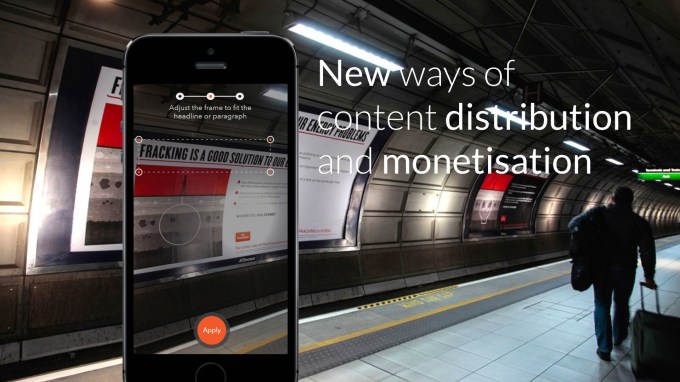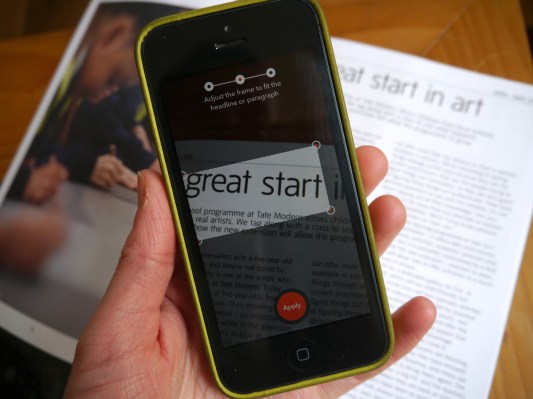It may surprise you but print media isn’t dead yet. Hell — some people even like reading ink off of pulped tree. And that curious fact is something U.K. startup Peekster is intending to cash in on — with an app (yes, it’s still an app) that links offline reading habits with online socializing and sharing habits to please old school readers and publishers alike.
We’ve covered this startup before, as a graduate of last year’s Wayra UK accelerator intake. But today Peekster is strutting its stuff on stage at TechCrunch Disrupt NY in our battlefield competition, and has just announced it’s launching its app in the U.S. today.
Peekster’s U.S. launch publications are the New York Times, the Wall Street Journal and the Washington Post, which join the six existing U.K. publications (The Times, Independent, Metro, The Guardian, the London Evening Standard and City AM) already supported by the app.
Users of Peekster who like to read these learned journals in dead tree form will be able to whip out their smartphone and digitally ‘clip’ an article from the paper edition they’re reading by scanning a few words from the headline or first paragraph.
When I say ‘clip’ — which Peekster calls tagging — I mean the app will locate the digital version of the article a user is reading so they can share it online with their social networks, or save it for later reading (Peekster integrates with read-it-later services such as Pocket and Instapaper for that). In other words, the app enables a newspaper reader to connect their offline reading with their online identity and networks.
The iOS app uses optical character recognition to figure out what the iPhone’s camera is pointing at and point the user to the correct online article. Where a publication’s content is not currently being linked to within the app, Peekster will suggested related similar articles based on the words the user scanned — so you can use it as a related content discovery engine too, if you wish.
On the discoverability front, the app also curates a real-time list of popular tags — based on what the community of Peekster users is scanning. So its pitch to publishers is that it can also help bring in new readers, as well as linking their offline readers to their online content.
To be clear, Peekster says it is not maintaining a database of publishers’ content itself (to avoid any copyright issues). It’s either looking at a publication’s RSS feed to locate the content a user is after, or doing a web search, says co-founder Tine Hamler. Although he adds that it does do some headline and URL indexing to speed up internal searches.
[gallery ids="994738,994737,994735,994736,994760,994761"]
Since there’s no database to build out, the only real reason for Peekster limiting the number of publications whose content is accessible within its app is on business model grounds. Ultimately it’s hoping to be able to persuade a sub-set of publishers to pay for the privilege of having their content in front of Peekster’s audience.
But to do that, it needs a sizeable enough audience to encourage publishers’ to pay — so this chicken/egg is not there yet.
Peekster needs some content to get readers interested of course — hence it’s starting by offering a limited selection of mainstream publishers’ content without them having to pay it, in the hopes that the ability to locate their content will help it amass enough users to get other publishers interested in paying to get content accessible within the app. (This is one of the reasons it’s focused on adding free newspapers in the U.K., says Hamler, owing to the potential volume of readers that brings in.)
Peekster is not currently breaking out app user numbers — but the app only launched last November so that’s not too surprising. Hamler says its active weekly user percentage is around 15% and that’s also something it will need to ramp up if it’s to make itself attractive enough to get publishers to pay. The startup itself was founded in May 2013, on selection by Wayra U.K.
That’s its only funding to date too. Now, post-Wayra, Hamler says it’s looking to raise a half a million dollar seed round and is currently meeting with investors — with the hopes of being able to close the round in about four months.
In the future publishers will need to advertise their content — not just their brand, but also the content; the articles themselves
While you might think it’s a retrograde choice for a startup to build a digital business atop very-long-in-the-tooth media format (print), Hamler argues there’s life left in dead tree media — and, over the longer term, an opportunity to provide publishers with technology to help them promote and sell individual articles in a mostly digital future.
“We saw a lot of people reading newspapers on Tubes, on public transport… and we did some market research and found out that people still rather prefer print over digital when commuting to work,” he says, explaining the genesis of the idea for Peekster. “The over 35s are still big print consumers so we checked the market and 80% of all the publishing industry is still on print, and only 20% is on digital subscription.
[gallery ids="998085,998084,998083,998077,998076,998075,998074,998073"]
“Also print brings in most of the revenue for publishers, and so we thought why not? Why not try and make print more interesting — why not include popular services from the Internet, like sharing stuff, like saving stuff.”
But the grand vision of Peekster goes beyond the current generation of print media — so ultimately isn’t tethered to print publications. The app’s makers envisage a future where big name publishers require new ways to flag up and distribute their content in an increasingly crowded marketplace of digital content.
“Print is declining but at the moment it’s still a pretty huge market,” says Hamler. “But in the future we believe that we will witness a big change in content distribution because all the content will be online and it will be hard to stand out and be found… We want to play a part in this. Our idea is that in the future publishers will need to advertise their content — not just their brand, but also the content; the articles themselves.”
Hamler points to billboard advertising campaigns that have been run by the Economist which present different angles of a story and encourage viewers to text certain keywords to get sent a copy of the publication as an example of the kind of advertising that large publishers are increasingly going to have to turn to, to drive interest in their content.

“I think print will go down that road — that content will be advertised on billboards and so on. It will be great for Peekster because you’ll be able to just scan the billboard and basically buy that one article with an in-app purchase,” he adds.
In the mean time, while it waits to enable a future where readers pay per article (at least from publications which can afford to advertise their wares on billboards), Peekster has several revenue strands in mind — including, hopefully in the near term, being able to persuade smaller publishers to pay for having their content included in its app.
It is also already taking revenue from other sources. Its basic app is freemium but certain advanced functions (such as exporting content to other services, and an offline mode feature) require an in-app purchase to unlock them. It’s also taking revenue from pushing promoted content within its app, collecting a fee per click on that.
Another possible revenue stream for the business is providing ‘Google analytics’ type services to print publishers — about the kind of articles people are looking at in paper newspapers and magazines.
Hamler says it may also look at licensing its technology (via an API) to publishers so they could add its ‘scan and tag’ function within their own apps — but he says those publishers it has talked to so far seem to prefer the concept of a standalone, independent service, which offers the chance of bringing in new readers, not just serving an existing readership.
Q&A
Q: Why did you go to the newspaper market first as opposed to billboards?
A: We see Peekster and printed media as a great driver to introduce Peekster to the audience because we can also count on publishers’ support as a way to promote their content
Q: Do you see print publications supporting it? It seems to me going to consumers and changing behaviour is a lot harder than going to the publishers and saying use this as a white label solution…
A: We are getting offers from publishers to white label.
Q: One aspect [of your pitch] is it’s in places where people don’t use their device, but you’re also expecting people to use their device so there’s a little bit of disconnect there –- so where are people doing the sharing? And also it seems like you really need the long tail of content? So how do you coach the user to use it?
A: Peekster is meant for print readers. So they consume content from print. Peekster is here just only for that second that the reader wants to share something to social media.
If we don’t find the right article for you we always suggest three similar stories so you can pick other articles from other publishers.
Q: Do you support reading in the app, like Pocket?
A: We link you directly to the website, but we offer in the future the option to remove all the clutter around the website, and then save to Evernote or Pocket or things like that.
Q: Do you see people coming back? Is there a way to bring users in more often than just grabbing a headline to share it?
A: Peekster is also widely used for content discovery – like you saw in the demo we provide this popular list, so you don’t need your print newspaper to discover new content.
Q: You’re doing OCR, so why couldn’t you just do a Google search to find the article that way?
A: We built a custom search that includes only publishers.
Q: What type of user data do you have to show that customers are sticking with it? To me it seems like you’re solving a problem that may not be a problem…
A: People are reading print because they like print. We have from 25% of our users are weekly active users.
Q: How often are they sharing content?
A: They are sharing on a weekly basis. The engagement rate is around 15%
